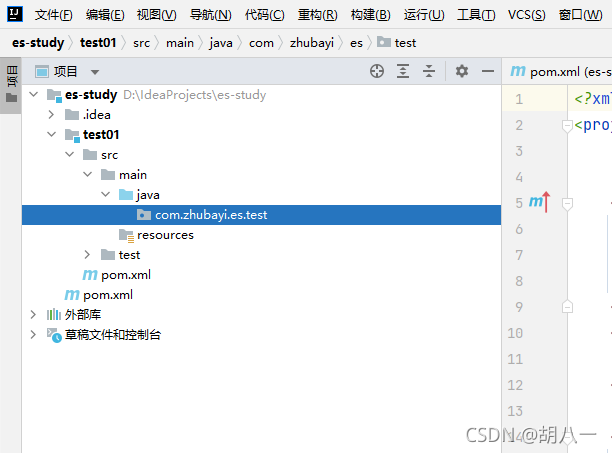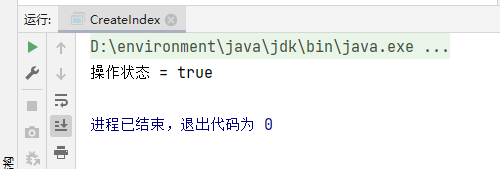Elasticsearch 软件是由 Java 语言开发的,所以也可以通过 Java API 的方式对Elasticsearch服务进行访问
1、 创建 Maven 项目
我们在 IDEA 开发工具中创建 Maven 项目(模块也可)ES


修改父项目的 pom 文件,增加 Maven 依赖关系
<properties>
<maven.compiler.source>8</maven.compiler.source>
<maven.compiler.target>8</maven.compiler.target>
<elasticsearch.version>7.12.0</elasticsearch.version>
<log4j.version>2.14.1</log4j.version>
<jackson.verdion>2.13.0</jackson.verdion>
<junit.version>4.13.2</junit.version>
</properties>
<dependencies>
<dependency>
<groupId>org.elasticsearch</groupId>
<artifactId>elasticsearch</artifactId>
<version>${elasticsearch.version}</version>
</dependency>
<!-- elasticsearch 的客户端 -->
<dependency>
<groupId>org.elasticsearch.client</groupId>
<artifactId>elasticsearch-rest-high-level-client</artifactId>
<version>${elasticsearch.version}</version>
</dependency>
<!-- elasticsearch 依赖 2.x 的 log4j -->
<dependency>
<groupId>org.apache.logging.log4j</groupId>
<artifactId>log4j-api</artifactId>
<version>${log4j.version}</version>
</dependency>
<dependency>
<groupId>org.apache.logging.log4j</groupId>
<artifactId>log4j-core</artifactId>
<version>${log4j.version}</version>
</dependency>
<dependency>
<groupId>com.fasterxml.jackson.core</groupId>
<artifactId>jackson-databind</artifactId>
<version>${jackson.verdion}</version>
</dependency>
<dependency>
<groupId>junit</groupId>
<artifactId>junit</artifactId>
<version>${junit.version}</version>
<!--<scope>test</scope>-->
</dependency>
</dependencies>

2、客户端对象
创建 com.atguigu.es.test.Elasticsearch01_Client 类,代码中创建 Elasticsearch 客户端对象因为早期版本的客户端对象已经不再推荐使用,且在未来版本中会被删除,所以这里我们采用高级 REST 客户端对象

public static void main(String[] args) {
// 创建客户端对象
RestHighLevelClient client = new RestHighLevelClient(
RestClient.builder(new HttpHost("localhost", 9200, "http"))
);
//...
// 关闭客户端连接
try {
client.close();
} catch (IOException e) {
e.printStackTrace();
}
}
注意:9200 端口为 Elasticsearch 的 Web 通信端口,localhost 为启动 ES 服务的主机名
3、索引操作
1、创建索引
public class CreateIndex {
public static void main(String[] args) {
// 创建客户端对象
RestHighLevelClient client = new RestHighLevelClient(
RestClient.builder(new HttpHost("localhost", 9200, "http"))
);
// 创建索引- 请求对象
CreateIndexRequest request = new CreateIndexRequest("user");
// 发送请求,获取响应
try {
CreateIndexResponse response = client.indices().create(request, RequestOptions.DEFAULT);
//响应状态
boolean acknowledged = response.isAcknowledged();
System.out.println("操作状态 = "+acknowledged);
// 关闭客户端连接
client.close();
} catch (IOException e) {
e.printStackTrace();
}
}
}
操作结果:

2、查看索引
public class CatIndex {
public static void main(String[] args) {
// 创建客户端对象
RestHighLevelClient client = new RestHighLevelClient(
RestClient.builder(new HttpHost("localhost", 9200, "http"))
);
//查询索引-请求对象
GetIndexRequest request = new GetIndexRequest("user");
// 发送请求,获取响应
try {
GetIndexResponse response = client.indices().get(request, RequestOptions.DEFAULT);
System.out.println("aliases:" + response.getAliases());
System.out.println("mapping:" + response.getMappings());
System.out.println("setting:" + response.getSettings());
//关闭客户端
client.close();
} catch (IOException e) {
e.printStackTrace();
}
}
}
操作结果:

3、删除索引
public class DeleteIndex {
public static void main(String[] args) {
// 创建客户端对象
RestHighLevelClient client = new RestHighLevelClient(
RestClient.builder(new HttpHost("localhost", 9200, "http"))
);
// 删除索引-请求对象
DeleteIndexRequest request = new DeleteIndexRequest("user");
// 发送请求,获取响应
try {
AcknowledgedResponse response = client.indices().delete(request, RequestOptions.DEFAULT);
// 操作结果
System.out.println("操作结果:" + response.isAcknowledged());
// 关闭客户端
client.close();
} catch (IOException e) {
e.printStackTrace();
}
}
}
操作结果:

4、文档操作
1、新增文档
创建数据模型
public class User {
private String name;
private Integer age;
private String sex;
public String getName() {
return name;
}
public void setName(String name) {
this.name = name;
}
public Integer getAge() {
return age;
}
public void setAge(Integer age) {
this.age = age;
}
public String getSex() {
return sex;
}
public void setSex(String sex) {
this.sex = sex;
}
}
创建数据,添加到文档中
public class AddDoc {
public static void main(String[] args) {
// 创建客户端对象
RestHighLevelClient client = new RestHighLevelClient(
RestClient.builder(new HttpHost("localhost", 9200, "http"))
);
// 新增文档-请求对象
IndexRequest request = new IndexRequest();
// 设置索引及唯一标识
request.index("user").id("1001");
//创建数据对象
User user = new User();
user.setName("祝八一");
user.setAge(22);
user.setSex("男");
ObjectMapper objectMapper = new ObjectMapper();
try {
String productJSON = objectMapper.writeValueAsString(user);
// 添加文档数据,数据格式为JSON格式
request.source(productJSON, XContentType.JSON);
//客户端发送请求,获取响应对象
IndexResponse response = client.index(request, RequestOptions.DEFAULT);
//打印结果
System.out.println("_index:"+response.getIndex());
System.out.println("_id:"+response.getId());
System.out.println("_result:"+response.getResult());
//关闭客户端
client.close();
} catch (JsonProcessingException e) {
e.printStackTrace();
}catch (IOException e){
e.printStackTrace();
}
}
}
操作结果:

2、修改文档
public class UpdateDoc {
public static void main(String[] args) {
// 创建客户端对象
RestHighLevelClient client = new RestHighLevelClient(
RestClient.builder(new HttpHost("localhost", 9200, "http"))
);
// 修改文档-请求对象
UpdateRequest request = new UpdateRequest();
//配置修改参数
request.index("user").id("1001");
//设置请求体,对数据进行修改
request.doc(XContentType.JSON,"sex","女");
//客户端发送请求,获取响应对象
try {
UpdateResponse response = client.update(request, RequestOptions.DEFAULT);
//打印结果
System.out.println("_index:"+response.getIndex());
System.out.println("_id:"+response.getId());
System.out.println("_result:"+response.getResult());
//关闭客户端
client.close();
} catch (IOException e) {
e.printStackTrace();
}
}
}
操作结果:

3、 查询文档
public class QueryDoc {
public static void main(String[] args) {
// 创建客户端对象
RestHighLevelClient client = new RestHighLevelClient(
RestClient.builder(new HttpHost("localhost", 9200, "http"))
);
// 创建请求对象
GetRequest request = new GetRequest().index("user").id("1001");
try {
// 客户端发送请求,获取响应对象
GetResponse response = client.get(request, RequestOptions.DEFAULT);
//打印结果
System.out.println("_index:"+response.getIndex());
System.out.println("_type:"+response.getType());
System.out.println("_id:"+response.getId());
System.out.println("source:"+response.getSourceAsString());
//关闭客户端
client.close();
} catch (IOException e) {
e.printStackTrace();
}
}
}
执行结果为:

4、删除文档
public class DeleteDoc {
public static void main(String[] args) {
// 创建客户端对象
RestHighLevelClient client = new RestHighLevelClient(
RestClient.builder(new HttpHost("localhost", 9200, "http"))
);
// 创建删除请求
DeleteRequest request = new DeleteRequest().index("user").id("1001");
//发送请求,获取响应
try {
DeleteResponse response = client.delete(request, RequestOptions.DEFAULT);
//打印信息
System.out.println(response.toString());
//关闭客户端
client.close();
} catch (IOException e) {
e.printStackTrace();
}
}
}
执行结果为:

5、批量操作
- 批量新增:
/**
* @author zhubayi
* 批量新增
*/
public class BulkAddDoc {
public static void main(String[] args) {
// 创建客户端对象
RestHighLevelClient client = new RestHighLevelClient(
RestClient.builder(new HttpHost("localhost", 9200, "http"))
);
//创建批量新增请求
BulkRequest request = new BulkRequest();
request.add(new IndexRequest().index("user").id("1001").source(XContentType.JSON,"name","zhangsan"));
request.add(new IndexRequest().index("user").id("1002").source(XContentType.JSON,"name","lisi"));
request.add(new IndexRequest().index("user").id("1003").source(XContentType.JSON,"name","wangwu"));
try {
//客户端发送请求,获取响应对象
BulkResponse responses = client.bulk(request, RequestOptions.DEFAULT);
//打印结果信息
System.out.println("took:"+responses.getTook());
System.out.println("items:"+responses.getItems());
} catch (IOException e) {
e.printStackTrace();
}finally {
//关闭客户端
try {
client.close();
} catch (IOException e) {
e.printStackTrace();
}
}
}
}
执行结果为:

- 批量删除:
/**
* @author zhubayi
* 批量删除
*/
public class BulkDeleteDoc {
public static void main(String[] args) {
// 创建客户端对象
RestHighLevelClient client = new RestHighLevelClient(
RestClient.builder(new HttpHost("localhost", 9200, "http"))
);
//创建批量删除的请求
BulkRequest request = new BulkRequest();
request.add(new DeleteRequest().index("user").id("1001"));
request.add(new DeleteRequest().index("user").id("1002"));
request.add(new DeleteRequest().index("user").id("1003"));
//客户端发送请求,获取响应对象
BulkResponse responses = null;
try {
responses = client.bulk(request, RequestOptions.DEFAULT);
//打印结果信息
System.out.println("took:" + responses.getTook());
System.out.println("items:" + responses.getItems());
} catch (IOException e) {
e.printStackTrace();
} finally {
//关闭客户端
try {
client.close();
} catch (IOException e) {
e.printStackTrace();
}
}
}
}
执行结果为:






















 773
773











 被折叠的 条评论
为什么被折叠?
被折叠的 条评论
为什么被折叠?








